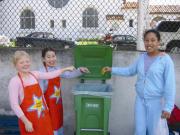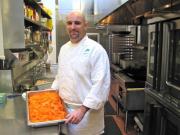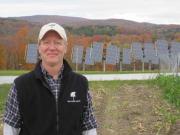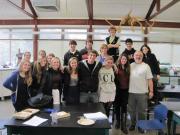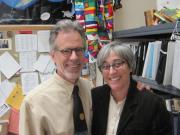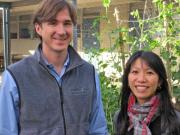Greening America's Schools 2.0: Summer and Fall 2012
In preparation for the publication of Greening America's Schools 2.0 in Winter 2013, I continued the search for best practices across the country. Here are profiles of five leading schools: 1. Waynflete School, ME; 2. Wilmington Friends School, DE; 3. Shipley School, PA; 4. Palmer Trinity School, FL; 5. Montgomery Bell Academy; TN.
1. Waynflete School: Progressively Green
Founded over a century ago in a residential section of Portland, Maine, Waynflete School has grown to become a thriving, progressive Pre-K through 12 independent school for 560 students that has embraced environmental sustainability as part of its larger mission. It has been my good fortune to know the school first-hand through the work of my friends, School Head Mark Segar and former Lower School Director Cinda Joyce. Together they teamed up with the Waynflete community to make respect and responsibility for the environment a central element of the school’s culture.
When Mark Segar became Head of School at Waynflete in 1994, he brought with him deep experience in education and in the natural world. Raised in a family of educators (his parents both worked at Shady Hill School), he discovered a love of nature during summers spent sailing on Cape Cod and holidays hiking in the White Mountains. Before coming to Maine, he had served as assistant to the Governor of New Hampshire on child development issues, and then headed the Common School, an ungraded elementary school in Amherst, Massachusetts, which itself has since developed an innovative partnership with an adjacent farm and environmental education center that affords wonderful opportunities for children to spend time in nature. In his years at Waynflete, Mark has tried to articulate the school’s essential values, including a commitment to sustainability, and to encourage colleagues to realize those values in program development and personal practice.
Cinda Joyce and her husband Steve became my close friends when he served as the Upper School Head at Head-Royce in the late eighties. When they moved to Maine, Cinda joined the Waynflete faculty to teach first and second grade and then served as Lower School Director from 1995 until her retirement in 2010. Asked why she and Steve became “attuned to nature,” Cinda reminded me that she herself was raised in Midwest, where her grandparents were farmers, and that Steve’s grandfather was an apple farmer. “We were rarely allowed to stay inside in the warm weather; we were sent outdoors to play and explore,” she recalled. “Our grandparents led sustainable lives,” and the “connection with food was so direct.” Together their lives are focused on the outdoors, gardening on their 11-acre farm, sailing in Casco Bay, hiking, birding, and traveling often to Nova Scotia. These experiences shaped Cinda’s belief that young children have an “innate affinity for bugs, dirt and anything in the natural world.”
As the Lower School Director, she felt the faculty was very “ecologically aware,” with many trained naturalists on staff who developed a heightened awareness when the environmental issues became national priority around 2005. They had “a real passion, an impatience, and were asking why the school was not doing more to respond?” Focusing that energy, the faculty set in motion steps that would transform the school.
The school’s mission “to engage the imagination and intellect of our students…and to encourage their responsible and caring participation in the world” led to the creation of a school-wide goal to “guide students to become active participants in the community as well as stewards of the environment.” In 2008 a new Green Team, including teachers and administrators and led by a Sustainability Coordinator (originally grade 4-5 teacher Kai Bicknell and now Carrie Branson, Executive Assistant to the Head of School), who shaped “a commitment to environmental sustainability” that is “woven into our daily practices and operations.” “We are continually exploring ways in which we may lessen our impact on the planet, reduce waste produced, and minimize our energy consumption,” they noted. “Our School’s commitment to the environment is an integral part of the curriculum set for every grade.”
The resulting Green Team Statement of Purpose has propelled changes at the school: “The Waynflete Green Team seeks to apply the School’s mission to our interaction with and impact on the natural world. Our aim is to create an atmosphere that expects conservation, promotes efficiency and encourages forward thinking on all issues of sustainable living and working practices. We strive to support and facilitate the school’s effort to reduce our ecological impact on the earth.” The well-developed statement urges all at Waynflete to pursue systemic change: to: “be models and resources for the larger community; work towards greater energy efficiency and reduction of waste across campus; heighten community awareness about environmental issues and greener practices; make visible our efforts around campus to become more environmentally sustainable; streamline systems so as to allow students and other members of the community to easily participate in greening efforts; support efforts to develop community investment in stewardship, across divisions of the school - on campus and off; support curricular threads that fall in line with environmentally sustainable practices and increased awareness of the natural world and its systems; and inspire behavioral change.”
Cinda Joyce encouraged faculty to incorporate sustainability in the LS curriculum, where “every classroom had a place-based orientation” inspired by work with David Sobel, writing by David Orr, the Center for Ecological Literacy, and Richard Louv’s, Last Child in the Woods. They developed an outdoor focus, with a motto that there is “no such thing as bad weather, only the wrong clothes!” Getting rid of a big play structure, they replaced it with natural materials, teachers brought in “found materials,” "inspiring children's imaginative and collaborative play as they invent endless possibilities using resources from nature." The school owns a nearby property along the Fore River, at the head of Portland harbor, with wooded trails, athletic fields, tennis courts, salt marshes and tidal creeks, and many curricular projects have been designed to take advantage of this “outdoor classroom,” including a focus on native Wabanaki culture, maritime history and traditions, and the salt marsh ecosystem. These efforts have been continued by the faculty and current Lower School Director Ben ThrashIn Spring 2010 the school created a garden, which families volunteer to tend in the summer. The fall harvest is used in the café, and the students produced a cookbook around the theme “where does food come from?”
The Lower School efforts are part of a wider and lively school commitment to going green. The Upper School begins each year with the Outdoor Experience and class trips to the Chewonki Wilderness Camp, Acadia National Park, and the White Mountains. With the Chewonki Foundation, the school has created an innovative, three-week summer program called Sustainable Ocean Studies: Inspiring a New Generation of Ocean Advocates. This past year Waynflete devoted a full professional development day to environmental sustainability and included the screening of a film called Waynflete Voices on the Environment, a compilation of student interviews from all three divisions answering questions like “what do you love about nature, where does trash go, and what are your hopes and concerns for the future of the environment?” In the spring the school offered Trashpalooza! “to develop a new ethic of environmental stewardship,” a week-long experiment with waste reduction in which student efforts to recycle, employ reusable lunch packaging, and increase composting led to a 44 percent overall reduction in waste. And the school also has planted a new "educational orchard" on campuses working with ReTreeUS, a local non-profit organization.
Head of School Mark Segar has provided supportive leadership and an eloquent vision for Waynflete’s environmental sustainability efforts. The school’s Board of Trustees decided the New Arts Center would become LEED certified. And the just announced Waynflete Strategic Plan: 2012 - 2017 establishes a commitment to “environmental sustainability in all facilities planning.” Writing to the Waynflete community before school began in September, Mark sent his fond hopes to community members, that “you’ll have a few more opportunities to watch from a porch while a thunderhead builds up, to read uninterrupted a few more chapters in that novel, or to take a kayak into one more cove.” With strong leadership and a deep community commitment to the environment, it seems assured that Waynflete will continue to become progressively green.
2. Wilmington Friends School: It’s a Gift to be Simple, It’s a Gift to be Green
Founded over 250 years ago by Quakers, Wilmington Friends, a pre-K through 12 grade school of 777 students, has developed a commitment to environmental sustainability that is both deeply rooted in the school’s values and an expression of the contemporary green school movement. Situated in the Brandywine River Valley just outside Wilmington on the site of a former farm, the school is adjacent to a large tract of protected open space that ensures the students are educated close to nature. For Head of School Bryan Garman, the school’s green initiatives stem from the belief that “stewardship is a vital part of the Quaker faith.”
Since his appointment as Wilmington Friends’ Head of School in 2006, Bryan Garman has worked with a deeply committed faculty and staff to create vision for environmental sustainability and make the school green. Raised in central Pennsylvania, he worked in a coal processing plant through high school and college and “saw firsthand the effects of environmental degradation.” A scholar by training, he received his B.A. from Bucknell and a Ph.D. in American Studies from Emory, later publishing A Race of Singers: Whitman’s Working-Class Hero from Guthrie to Springsteen. His experience working with school head Bruce Stewart at Sidwell Friends in Washington DC to green their school inspired him to develop a similar vision for Wilmington Friends; in his second year he arranged for the Property Committee of his Board to take a bus trip to view the school firsthand.
Soon Wilmington Friends was engaged in preparing a new Strategic Plan, and in 2008 they declared their intention to “establish a center to promote civic engagement and environmental responsibility” through curricular reform, partnerships, service learning, and a public lecture and performance series. The Plan also called for a new master plan that would reflect the “mission of environmental stewardship.” Bryan Garman is quick to observe that many members of the community embraced this vision and led the changes that followed. Especially important were Assistant Head of School for Finance and Operations Bill Baczkowski and Director of Facilities Ray Carbone, who helped lead a host of facilities improvements; Amy Ferris, whose staff helped green the cafeteria; and Rick Morrison, Vernon Stevenson, and Bill Miller, who led efforts to ensure that environmentally friendly products and practices were adopted in caring for the buildings and grounds. In 2011 Susan Finizio became the school’s first Environmental Stewardship Coordinator. A WFS alum, she was raised in the Brandywine watershed and was “always comfortable with nature.” With a degree in communications and an M.B.A, she served first as the school’s Communications Director. After taking a leave to raise a family, she returned as Family Resource Coordinator and is now also coordinating the school’s green efforts.
The creation of an Environmental Mission Statement helped focus the green schools initiatives as Wilmington Friends declared its desire “to elevate environmental stewardship to the forefront of both thought and action and to empower students, faculty, and staff with knowledge, tools, and opportunities to make positive changes for and contributions to a more sustainable world.” They further shaped an Environmental Policy in order to “weave environmental concepts throughout the curriculum…expose students to their natural surroundings…make institutional decisions always mindful of their environmental impact…build a community that not only reduces harmful behavior, but also makes positive contributions to the environment…use resources and materials to cultivate a healthy school…and network with other organizations/alliances focused on environmental stewardship.” The impact of this new vision, mission and plan has been powerful.
Examples abound of how the school is incorporating environmental practices into its culture. In facilities and operations, they transitioned from oil heat to a clean-burning gas heat system, replacing boilers originally installed in the mid-1950s, and the system’s efficiency has jumped from 50% to 95%. High-efficiency Low E windows have been installed throughout the campus, and renovations incorporate the most sustainable materials available. A building automation system remotely controls heating, cooling and lighting. Recycling of paper and plastics has been embraced, thanks to the leadership of faculty, and the organic kitchen waste is taken to a commercial composting facility. Wilmington Friends was the first school in Delaware to join the Green Schools Alliance and has made a pledge to seek further deep cuts in energy use. And the school is planning to build a new theater and gym that they hope will be certified LEED Gold by the U.S. Green Building Council.
Student engagement is central to the Wilmington Friends green initiatives. In 2008 a group of sixth graders approached Head of School Bryan Garman to ask that their school acquire solar panels. The group researched the project and made an impressive presentation to the Board of Trustees. In 2011 the school installed 860 solar panels on the Lower and Middle/Upper School buildings using a Power Purchase Agreement; the system will offset the total yearly energy consumption by 16% and save 170 metric tons of C02 from the atmosphere. Under the leadership of science teacher Carlos Charriez, sixth graders hosted a Zero Waste Week, which sought to raise awareness and decreases waste throughout the school and members of the Upper School Peace and Ecology Club, led by science teacher Ellen Johnson, organize a bi-annual Eco Day to educate their fellow classmates about sustainability.
To realize the vision of the Strategic Plan the school has created the Quaker Center for Understanding, Engagement, and Stewardship (QUEST) to oversee the school’s stewardship programs. The Center seeks to promote environmental education and “increase students’ understanding of the science behind stewardship issues,” to advance institutional stewardship, and encourage community outreach and service learning to “contribute to solutions to stewardship issues locally and beyond.” QUEST sponsors a Big Ideas Speakers Series that recently featured Dr. Eric Chivian, winner of the Nobel Peace Prize in 1985 for his work as co-founder of International Physicians for the Prevention of Nuclear War and founder and current director of the Center for Health and the Global Environment at Harvard Medical School.
When I first met Bryan Garman several years ago and mentioned to him my strong interest in helping to grow greener schools, he turned to me and said, “I have just the book for you, Right Relationship: Building a Whole Earth Economy, by Peter Brown and Geoffrey Garvey. Drawing upon the Quaker tradition of “bearing witness” and “living life in a way that reflects fundamental truths,” they argue that “we need to reorient ourselves in how we relate to each other and to the earth’s wonders through the economy” by adopting the virtues of simplicity and closeness to nature. Indeed, the song “It’s a Gift to be Simple,” often sung at Meeting for Worship, captures well the spirit that is alive at Wilmington Friends as the school pursues the vision of becoming a greener, more environmentally sustainable school.
3. Shipley School: From a Farm to a Greener School
The Shipley School in suburban Philadelphia was founded as a girls school in the 1890s, and in the early the early twentieth century the school heads owned and operated a 30-acre farm in nearby Gladwyne, providing eggs, milk, chickens, hogs, and garden vegetables to the school. Shipley today is a coeducational PK-12 independent school of 838 students, and while the original farm no longer operates and is now the site of playing fields, students at the school have recently started a garden that helps provide produce for the two cafeterias. That initiative is symbolic of the larger efforts underway to help Shipley become more environmentally sustainable.
While attending a meeting at Pomona College in June with Shipley’s head, Steve Piltch, I mentioned my interest in “growing greener schools,” and he replied, “I am very proud of what our community has begun to do to become more sustainable.” As he later observed, “We understand how important this work is for all of our schools. We want and need to be part of the solution. I look forward to having us do more and more as time goes on.” In the last several years Piltch has outlined the challenges, and the opportunities, facing his community. Moved by a series of extreme weather events in the East, he wrote to the school community in April 2010 on the 40th anniversary of Earth Day about “the vulnerability that we have seen in the past months” that is “but a microcosm of greater environmental issues.” “Over the years,” he said, “society has underestimated or ignored the potential impact of our decisions and behavior on the long-term health of our environment, in part because we could not or chose not to see the issues in the moment.” He continued: “While it might take a significant change in our styles of life to make a major impact quickly, we can do small things to protect our own environments. For example, here at school we are working more collectively to recycle. We are using fewer bottles of water and are paying attention to the electricity consumption in ways that we haven’t in the past. We have begun to put in lighting and windows that save energy. And as we plan new facilities, we anticipate building them in as environmentally friendly ways as possible. We know that whatever we do or don’t do will affect generations to come.”
Nearly a decade ago the school began the process of greening the school when they developed a new master plan that envisioned a 39,000-square-foot LEED-Certifiable Learning Center and Dining Commons, a small outdoor amphitheater, artificially turfed playing fields, and a new gym. The building will contain new kitchen facilities, a 3,500-square-foot dining hall, and a 6,500-square-foot library/research center as well as classrooms for music and art, and a “grey box” to be used for theater and music performances, meetings, and assemblies. As the school notes, “Constructing an environmentally responsible building is in keeping with Shipley’s overall mission of ‘compassionate participation in the world’ and will serve as a model and example of civic conscience for students and the entire Shipley community.”
Following the economic crisis in 2008, Shipley moved to revamp its operations to save money and the environment. “Tough economic times call for tough decision-making,” they noted, and provide “an opportunity to rethink the way we spend our money and to make decisions that help our bank account and the environment at the same time.” One of the most visible initiatives is the Shipley Energy Challenge, an effort developed by Controller Jayme Karolyi to promote “Shipley’s saving green by getting greener.” Concerned about the school’s high energy bills, she created a competition for faculty and students to “turn out the lights, turn down the thermostats, and to be more conscientious about energy usage,” and she rewarded the winners in the building that recorded the greatest savings. Raised in Philadelphia’s Center City, her interest in the environment was awakened when as a child she attended the Springhouse Day Camp outside of the city and later became a camp counselor there as a teenager.
Karolyi and her colleagues CFO Adam Wojtelwicz and Director of Physical Plant Bob Meals have teamed up to implement changes that are not only “good for the environment, but can actually reap financial benefits in the long term.” The annual report is now posted on line, saving the school roughly $20,000 and 170,000 pieces of paper. With the adoption of ShipleyNet, a password-protected side of the school’s website, they are going paperless. Other efforts include an expanded program of composting and recycling, the installation of more efficient lighting, the installation of carpeting made from recycled material, and the use of green products in housekeeping materials.
Shipley’s students are helping to lead the environmental sustainability effort. The Upper School Green Gators environmental club won first place in the Lexus Eco Challenge, a national environmental competition to promote wind power, and the students shared $35,000 in scholarship money and the School received $15,000, which is being used for green initiatives in the Upper School. After attending a leadership institute at Brown University in 2011, Shipley student Hannah Cutler ‘13 began a community vegetable and herb garden on the Upper Campus that has caught the fancy of many students and people in the local community alike. Students in the school’s Global Studies class read Thomas Friedman’s The World is Flat, and attended a lecture on his new book, Hot, Flat, and Crowded. As Zachary Laskin '10 wrote, Friedman “believes that Americans should begin working on green solutions for the future so that when ‘going green’ becomes an economically sound policy, or is incentivized, America would once again be able to provide the technology and skilled labor to bring ‘green’ technology to the world.” He was especially moved by Friedman’s observation that to fix the environmental crisis “we have exactly enough starting now.”
That sense of urgency is leading Shipley to consider future initiatives. They are looking at photovoltaic solar panels to further reduce energy costs, use of storm water runoff for irrigation and toilets, and green roofs. As Jayme Karolyi observed: “Shipley is committed to the continuance of our green efforts. We consistently look for ways to enhance our environmental sustainability, as well as pursue ways to financially enhance environmental sustainability now and in the long term. Our continued objective is to get the entire school, students and colleagues, involved in this effort.” Shipley is clearly on the way to becoming a greener school.
4. Palmer Trinity School: Sustainability in a Green Glade
Palmer Trinity School (PTS) is located about ten miles south of Miami on the beautiful Florida coast, in the middle of a remarkable ecosystem, bordered to the west by the Everglades and to the east by mangrove preserves and Biscayne Bay. The school community’s “sense of place” has helped Palmer Trinity, a 6-12 Episcopal school of 650 students, embrace environmental sustainability. And their leaders have created a vision of how to become greener school.
When Sean Murphy became Head of School in 2003, he found the school well poised to become greener. The previous year the Board of Trustees had approved a new strategic plan with just three goals: achieving excellence, building Episcopal identity and “committing to stewardship.” For Murphy, the spiritual admonition to be the “keeper of the garden” has helped inspire the school’s efforts. He also brought to the school his own belief that educating students in nature is vital. Raised in New Mexico on a farm where he tended his own garden at age 10, he attended Albuquerque Academy, where he later taught for fifteen years and saw the value of the well-developed outdoor program. As a local writer in Florida observed, “When Murphy arrived on campus, he transformed the school into a leader in environmental sustainability by giving students and teachers the tools to be innovators, empowering them to make a difference and teaching students environmental and health values that will stay with them throughout their lives.” (Wave, Fall 2010)
In 2007 Murphy felt fortunate to hire Leopoldo Llinas to teach science, and then to become the school’s Sustainability Coordinator. A native of Bogota, Columbia who was completing his Ph.D. in marine biology at the University of Miami, Llinas conducted research on climate change in the Artic and eagerly taught A.P. Environmental Science and chemistry, while taking on the larger task of organizing the school’s green efforts. As advisor to the Ecology Club, he has encouraged student leadership, and he is now organizing a new faculty Green Team. With a broad portfolio, Llinas has encourage the school’s green efforts, working with students, faculty, administration and parents.
The impact of this mission-driven effort to become more environmentally sustainable is evident throughout the school’s program. Year’s ago the school adopted a cosmology curriculum to teach students about Earth’s 4.6 billion year history. The curriculum now uses the local ecosystem to create units ranging from shark tagging to food web mapping. The academic program is enhanced by an outdoor education program that enables students to participate in a wilderness survival program at an environmental center in Miami-Dade County and a special program for all ninth graders designed by Outward Bound. A grant from the Edward E. Ford Foundation enabled PTS to create a new Coral Lab, a center for education, training, and research in marine biology. Another innovative program called the Fairchild Challenge, sponsored by a nearby tropical botanical garden, is a “multidisciplinary, environmental education outreach program designed to give school students an opportunity to shine through friendly competition.”
Students at Palmer Trinity have taken a leadership role in greening their school. Through the community service program, students organize a number of green service projects including a beach clean up, nearby mangrove planting, and dune restoration. The Reclamation Project engages students in gathering hundreds of mangrove “propagules” from the coastal areas, nurturing them into seedlings and planting them to create new habitats. And annually students host a Sustainability Fair where they display research projects on topics that range from renewable energy to reducing greenhouse gas emission.
With the leadership of Leopoldo Llinas and the staff, the school has begun to adopt green facilities policies and practices. The single-stream recycling program is well developed, fuel efficient vehicles are given special parking priority, the maintenance staff use environmentally friendly cleaning products, and a 20 kW photovoltaic system provides renewable power to the school’s concession stand and the main library. In a process called “naturescaping,” the school selects plants and shrubs that grow naturally in South Florida, which are low maintenance and require less water, fertilizers or pesticides. The waterless urinals each save an average of 20,000 to 45,000 gallons of water a year. A “living garden” gives students a chance to learn how to grow local and organic food, some of which is served at the school’s cafeteria. And the butterfly garden enables students to learn about what plants attract butterflies and ways to improve the environment.
In recent years the school acquired a large, 30-acre mango grove adjacent to the southern boarder of the campus, a development that promises a bold new future for the school. By removing the mango trees, an introduced, invasive species, the school hopes to return portions of the land to native plants. The master plan will allow the school to nearly double it student body, and the planned construction will be LEED certified. Sean Murphy is enthusiastic about this future, one led by a Board whose “culture is strongly supportive of sustainability.” Palmer Trinity School’s leaders hope to “create replicable models for how to make schools sustainable.” As they build their school in a green glade, we can all benefit from their example.
5. Montgomery Bell Academy: A Balanced Approach to Sustainability
In 2003 Montgomery Bell Academy, an independent school in Nashville, Tennessee, enrolling 715 boys in grades 7 through 12, launched a bold capital campaign to raise $100 million to strengthen the academic program, support faculty and staff, and improve the campus facilities. The desire “to meet the needs of the entire community” led the school to embrace a vision of environmental sustainability that “allows MBA to educate its students on the value of efficiency both financially and within the community.” Called “A Balanced Vision,” the effort that resulted has transformed the campus, and the community, through an approach that has been harmonious, even, and measured.
The school’s leadership has clearly been instrumental in developing MBA’s commitment to environmental sustainability. MBA Head of School since 1994, Brad Gioia credits his own environmental awareness to his experience being educated in “beautiful places,” including Sewanee: The University of the South, about 100 miles south of Nashville, and Middlebury College in Vermont. Some years ago, he and his wife purchased a home in historic Leiper’s Fork, Tennessee; adjacent to several hundred acres of National Trust land, and recently they installed a geothermal energy system to make it energy self-sufficient. When the school decided to embark on a major campus renovation, they selected an architectural firm headed by an MBA alumnus, William Hastings (’90), who himself had designed and built the first LEED (Leadership in Energy and Environmental Design) building in Tennessee. And the MBA’s current board chair, James Webb (’66), built a LEED Gold office building and donated a 200-acre property at Long Mountain to the school for use as an outdoor education and retreat center. To develop a shared vision for the school’s future, Gioia and the board began nearly two decades ago to hold their annual retreat in other places, from Philadelphia to St. Louis, and from Atlanta to Washington D.C., so that they could learn about best practices. The net result has been to forge a leadership team that has achieved remarkable results.
As they began to transform the campus, the Board made a commitment “to become LEED certified for all new construction.” In 2003 this required a financial commitment, for as Gioia notes, “Becoming LEED Certified is an expensive process and Montgomery Bell is committed to following through with its pledge to become an environmentally friendly institution.” Thus far, MBA has completed four new buildings, all LEED certified, including Mary Helen Lowry Hall, an Observatory at Long Mountain, a parking garage, soccer field and rifle range, and a tennis center. Currently, a new dining hall is under construction and renovations are planned for the gym, classroom buildings and the library, all to be LEED certified. The installation of a $600,000 geothermal system required a special commitment given its expense and 8 to 10 year payback, but the project also enabled MBA to create a bioswale flood-control system for the Kingfisher Creek that flows through the campus and the surrounding neighborhood. The positive environmental effects of the campus-wide LEED certification effort are many, including water conservation using low-flow fixtures and a cistern for landscaping, energy use that is 36% more efficient than the “baseline” for comparable buildings, and construction that uses recycled materials and diverts waste from the landfill. The school is now evaluating the potential to add renewable power through solar photovoltaics.
Rebuilding the school according to the best principles of sustainable design has clearly impacted MBA in many other areas. The Long Mountain property, which “features a pristine lake, two fields, walking/hiking trails, zip lines, and a recently completed observatory,” is used regularly for class trips, leadership retreats, and outdoor education. The campus garden, which provides produce for the school’s dining program, is run by a member of the science department who has arranged a partnership with the ‘Nashville Urban Gardeners, “a group of local chefs and foodies advocating awareness, knowledge, and the implementation of sustainable gardening and farming initiatives” who “intend to spark the desire in others to move closer to the earth and remind the world of the beauty of food that has been perfectly created by nature without chemicals, preservatives, or unnecessary and unnatural processes.” The food program itself is run by SAGE Dining Services, whose executive chef has brought scratch cooking and a focus on healthy nutrition to MBA. And the school has begun to embrace ecological literacy in the academic program, through projects that use the campus as a laboratory and buildings that are well signed to explain the principles of green design.
As the Montgomery Bell Academy mission states, the school “offers young men an exemplary college preparatory experience, assisting them to be ‘gentlemen, scholars, and athletes’ and young men of wisdom and moral integrity who will make significant contributions to society.” The school was the model for the acclaimed 1989 film, “Dead Poets Society,” written by an alumnus who was clearly shaped by the values expressed in the mission. Now, as the school deepens its commitment to environmental sustainability, it is preparing young men with the independent spirit depicted in the film who can help address the significant challenges the planet faces.
Montgomery Bell Academy offers young men an exemplary college preparatory experience, assisting them to be "gentlemen, scholars, and athletes" and young men of wisdom and moral integrity who will make significant contributions to society Montgomery Bell Academy offers young men an exemplary college preparatory experience, assisting them to be "gentlemen, scholars, and athletes" and young men of wisdom and moral integrity who will make significant contributions to society.
